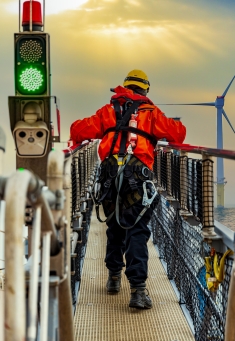







Summary
California’s offshore wind industry can fill its workforce training needs largely through negotiating labor contracts with unions, thus providing access to the state’s well-honed apprenticeship system. But some workforce gaps exist in the offshore marine services, caused mainly by legal and regulatory hurdles. These are some of the key findings of a new, state-funded report issued by an alliance of industry, labor and academia. Unlike many other desktop research reports issued in recent years about California offshore wind, this report was based on empirical, hands-on planning for California’s first offshore wind project: CADEMO in northern Santa Barbara County.
The new report was produced by the Offshore Wind High Road Training Partnership (HRTP), funded by the California Workforce Development Board. The HRTP members include: Floventis, CADEMO’s owner and developer; the State Building and Construction Trades Council; electrical union IBEW 1245; San Luis Obispo County Office of Education; SLO Partners; and Cal Poly San Luis Obispo.
CADEMO is a demonstration project comprising four full-size, 15-MW floating turbines in state waters off the coast of Vandenberg Space Force Base. It is expected to be operational in late 2027, years before the first larger-scale projects planned in federal waters.
Key findings of the report:
- Labor relations and workforce: California’s offshore wind developers should start negotiating with labor unions sooner than later. Negotiating a master Project Labor Agreement (PLA) for CADEMO took two years, and the five winners of the federal government’s 2022 offshore wind auction will find the process to be complex. Achieving a PLA not only cements a strong partnership with labor unions for the project’s regulatory permitting process, it ensures access to the state’s apprenticeship system to resolve workforce training needs.
- Supply chain: For CADEMO as well as the big projects in federal waters, the most difficult needs for supply chain and workforce are in the marine sector, including the launching of floating platforms from wharf into water, the final turbine integration, and the anchor and cable laying. These gaps are caused largely by the Jones Act (requiring U.S.-flagged vessels) and California’s newly strengthened offshore emissions standards. These urgently need the attention of state and federal government agencies in cooperation with the offshore wind industry.
- Ports: For CADEMO and initial projects in federal waters, California is unlikely to manufacture the turbine components – towers, nacelles, and blades – and these must be imported from out of state. But the construction and assembly of floating offshore platforms could and should take place in California. This will require the state and federal governments to focus quickly on upgrading ports facilities, with a primary emphasis on construction only, leaving manufacturing as a second priority.
- Central Coast: Despite initial public discussions in the Central Coast region about a possible new mega-port facility in the area where offshore wind projects could create thousands of local jobs, we found such a scenario to be highly unlikely. The only port locations where construction, assembly, and final integration of the floating platforms might be feasible are located elsewhere in the state. As a result, offshore wind job creation in the Central Coast region will be relatively modest.
- Jobs: Research by the Cal Poly Orfalea College of Business for the Offshore Wind HRTP projected that CADEMO will create a total of 697 jobs statewide during the construction phase, and 16 annual jobs in the Central Coast region during the long-term operations phase. The Cal Poly analysis also projected that each one of the three, gigawatt-scale projects in the federal Morro Bay offshore wind zone will create 10,025 construction jobs statewide and 494 long-term operations jobs locally.

Contributors
HRTP Program Liaison: Rafael Aguilera, California Workforce Development Board
HRTP Grant Administrator: Michael Specchierla, San Luis Obispo County Office of Education & SLO Partners
HRTP project coordinator and lead author of report: Robert Collier, Floventis Energy. Report co-authors: David Vallee and Miriam Noonan, Floventis Energy; Stephanie Tsai, consultant. Copy editor: Deborah Meacham. Designer: Toben Dilworth.
The Economic and Employment Impact of Floating Offshore Wind Projects in California’s Central Coast: Cyrus Ramezani, Ph.D. and Mahdi Rastad, Ph.D., Cal Poly San Luis Obispo Orfalea College of Business.
Acknowledgments
Special thanks for support in this HRTP to the following individuals: Jeremy Smith, State Building and Construction Trades Council of California; Joshua Medrano and Martin Rodriguez, Tri-Counties Building and Construction Trades Council; Nancy Rader, California Wind Energy Association (CalWEA); Marina Secchitano, Inlandboatmen’s Union of the Pacific; Sean Farley, International Longshore & Warehouse Union; and Benjamin Ruttenberg, Cal Poly Center for Coastal Marine Sciences.
PARTNERS







